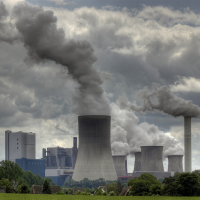Despite Dangers, U.S. Increases Dependence on Coal for Electricity
 (photo: NYU)
(photo: NYU)
Conservatives opposed to President Barack Obama’s plan to have the Environmental Protection Agency (EPA) regulate carbon emissions for power plants because the market for fossil fuels is already encouraging a switch from coal to natural gas will have to find a new argument, according to a recent report from the Department of Energy.
The U.S. Energy Information Administration (EIA) reported last week that U.S. power plants in the past year have actually increased their use of coal while decreasing their use of natural gas, reversing a recent trend from gas to coal. Specifically, coal’s share of domestic power generation in the first quarter of 2013 averaged 39.5%, up 4.1% from 35.4% last year. The share for natural gas dropped 3.7%, from 29.5% to 25.8%. The agency also predicts that coal use will continue to grow, with 40.1% of electricity generated by coal through 2014, while natural gas use will fall to 27.3%.
Given the fact that power plants are the largest source of greenhouse gases, one unavoidable result of the shift is more greenhouse gas emissions. EIA projects that CO2 emissions from fossil fuels will grow by 2.4% this year and by 0.6% in 2014, after falling about 3.9% in 2012. Obama had ordered EPA to develop rules by 2014 to cut greenhouse gas emissions from power plants even before issuance of the EIA report.
The reason for the shift, according to EIA, is simply that the price of gas rose while that of coal dropped. Many utility companies have technology allowing them to switch between coal and natural gas, and do so depending on which option is cheaper.
And thus exposing a key problem with relying on market activity to achieve social goals: in setting prices markets account only for those costs that are borne individually, but entirely ignore costs that are borne socially. In the case of electric utilities, the price of coal accounts for the costs associated with its extraction, processing and transportation, but excludes the cost of global warming it causes.
As James Bradbury of the World Resources Institute, told The Los Angeles Times, “Markets on their own may go in your direction for a period of time, but to ensure that we get reductions in greenhouse gas emissions in a significant, sustained way, you’re going to need government intervention.”
-Matt Bewig
To Learn More:
U.S. Power Plants Use more Coal, Bucking the Trend toward Natural Gas (Homeland Security Newswire)
Use of Coal to Generate Power Rises; Greenhouse Gas Emissions Next? (by Neela Banerjee, Los Angeles Times)
Big Energy Firm Agrees to Replace Coal-Burning Plants with Wind and Solar Operations (by Noel Brinkerhoff and Danny Biederman, AllGov)
- Top Stories
- Unusual News
- Where is the Money Going?
- Controversies
- U.S. and the World
- Appointments and Resignations
- Latest News
- Trump to Stop Deportations If…
- Trump Denounces World Series
- What If China Invaded the United States?
- Donald Trump Has a Mental Health Problem and It Has a Name
- Trump Goes on Renaming Frenzy






Comments